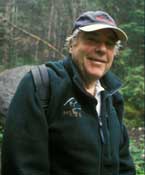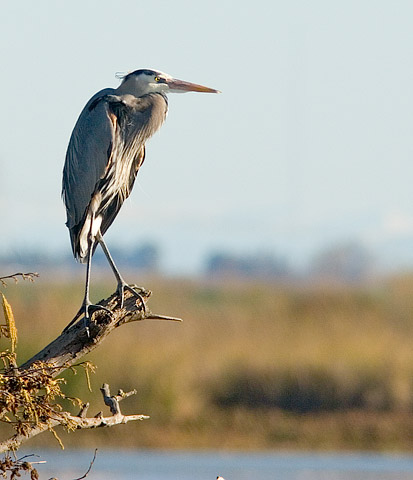
A life-changing accident gave former Cal academic Ronn Patterson time to think long and hard about his life path. He ended up founding Dolphin Charters, which leads guided natural history cruises and photo expeditions to wildlife hotspots in North and South America.
Captain Ronn moves with the wildlife: In the spring and fall, he takes his passengers on day trips to the California Delta and San Francisco Bay to watch migrating seabirds on the Delphinus, a 50-foot trawler. Winters he cruises the Gulf of California and the Galapagos. And summers are spent in Alaska and British Columbia, following migrating whales and birds on their return north.
BN: When did you start Dolphin Charters?
RP: In 1982, a few years after leaving my job as Chair of the Science and Math department at UC Berkeley Extension. In between I co-founded a whale education and research organization and worked to get a moratorium on whaling worldwide.
BN: What spurred you to move from an academic life to leading guided nature tours on the water?
RP: A car accident. I was driving home from a Pacific seabird conference in Monterey when my car hit a tree at Robbers Gulch in San Benito County. It was a near-death experience; I spent two months in the hospital and another few months recovering at home.
BN: How did the accident change your life?
RP: It made me think about what really mattered. I decided I wanted to go to work for myself – and for the environment. My background was in marine biology and my specialty was whales. I also enjoyed boating. And three quarters of the earth is water, so I thought it would be good for people to learn what is out there.
BN: Are you a Bay Area native? If not, what brought you here?
RP: No, I’m originally from the Midwest. The mountains and ocean brought me here—an opportunity to climb mountains, not stairs.

BN: Can you tell me a bit about your academic background? Where did you get your degree(s), and in what field(s)?
RP: I received a BA in biopsychology from University of Chicago and a Masters in Zoology from UC Berkeley.
BN: When and where did you learn boating?
RP: I built a kayak-like boat in junior high and then worked on ore freighters on the Great Lakes during summers while I was in college.
BN: Tell us about your work with whales.
RP: I became interested in them while studying invertebrate zoology at Berkeley. I first focused on gray whales and subsequently humpbacks and orcas. After leaving Cal I co-founded the Whale Center, a research and education organization based in Oakland, with Maxine McCloskey in the late 1970s. [Ed: The Whale Center gave life to the beloved Whale Bus, a traveling exhibit which brought whale education to Bay Area schoolchildren and later inspired the Marine Mammal Center’s own marine science exhibit on wheels.] We were an active presence at International Whaling Commission meetings. I also worked on various projects for NOAA’s National Marine Laboratory, studying and counting bowhead whales in Alaska, gray whales off the coast of California, and bottle-nosed dolphins in the Banana River in Florida.
BN: What did you do at the IWC?
RP: I played different roles: as delegate, as an NGO observer, and finally, as a member of the scientific committee. My stint at IWC was the least fun I’ve had in my life — mainly because of the politics involved — but I stuck with it until we got a worldwide moratorium on whaling in 1982.
BN: What are your favorite places to lead cruises, both locally and abroad?
RP: In the Bay Area I like the Bay and some of its creeks, the Petaluma River and the Napa River, Suisun Marsh, and the thousand miles of the “amazing maze” of waterways in the central Delta. Beyond the Bay, I love the wilderness of Southeast Alaska and British Columbia. And then there’s the Gulf of California in Mexico – one of the “whaliest” places I know; and the Galapagos and the eastern Amazon.
BN: What draws you to the Delta?
RP: The Delta is California’s watering hole, with three-quarters of our population getting some to all of its water there. Forty percent of the entire land surface of California drains into it. It is very important that people know about it – or better yet, care about it.
At the same time, it’s California’s very best wildlife habitat, containing everything wildlife needs in abundance: food, water, and shelter. It’s where the greater portion of the 1.5 million migrating birds on the Pacific Flyway spend the winter. You can see eighty species of birds, like tundra swans, snow geese, and Sand Hill cranes. We’ve also seen beaver and muskrat and river otters.
BN: Why do you do this work?
RP: I want to get people interested in and engaged in an understanding of our home, three quarters of which is water. Just being on the water gives us another perspective. The river systems that feed into the Bay are extremely important and most people never have a chance to see and learn about them. My work is fun, interesting and I enjoy sharing with and learning from the wonderful folks that come on the trips. I doubt if I could stop.
BN: Do you still climb mountains?
RP: Yes. When we’re in Alaska we try to get off the boat every day for hikes and some of those hikes are, uh, strenuous. But sometimes the whales and marine life are so engaging we don’t even make it off the boat!
Learn more:
Dolphin Charters offers 7-10 day whale watching and natural history trips in Southeast Alaska each summer and 60-70 day trips in California a year, in the spring and in the fall. For more information, and to view Dolphin Charters’ full trip schedule, please visit dolphincharters.com.





